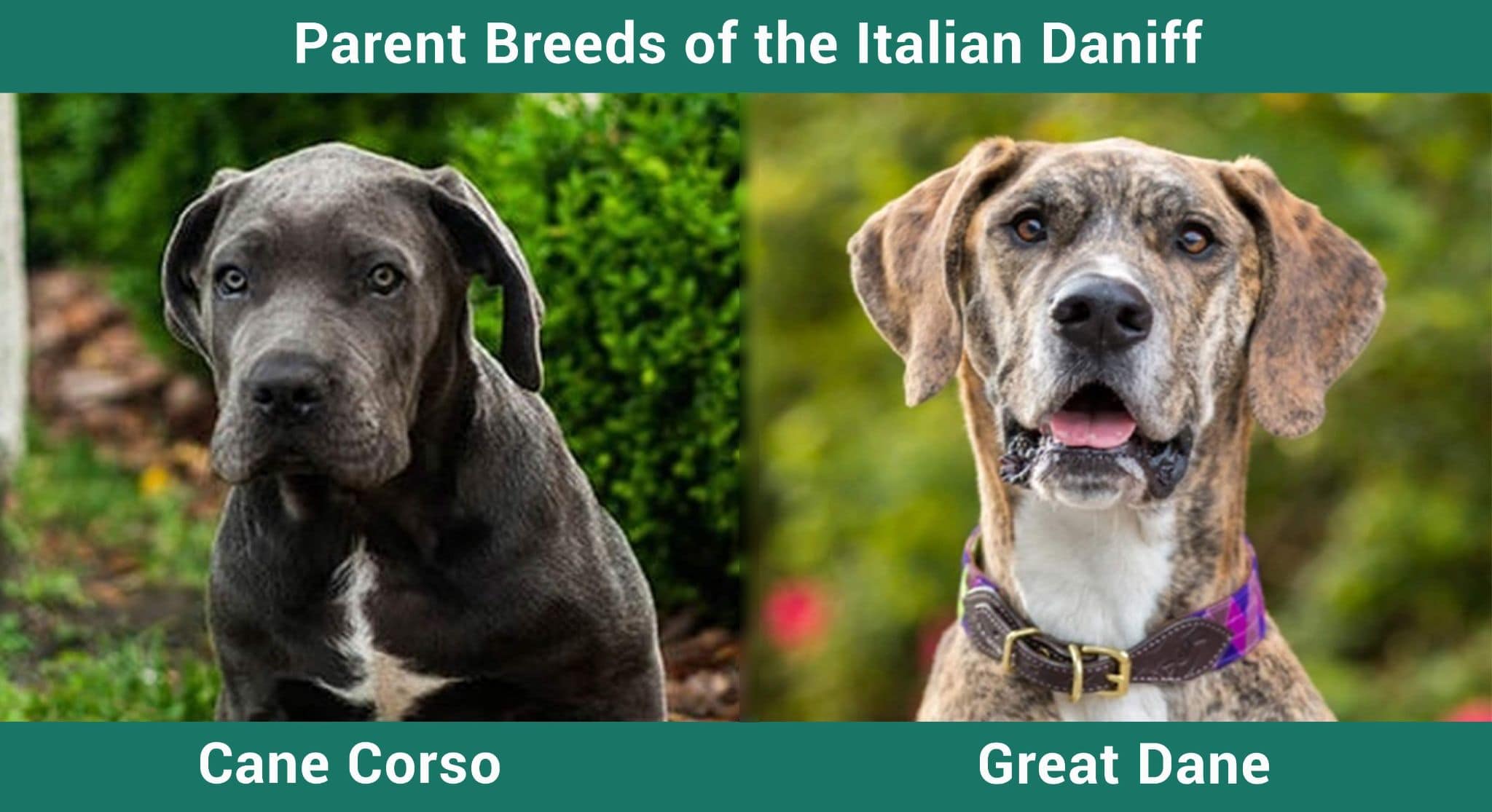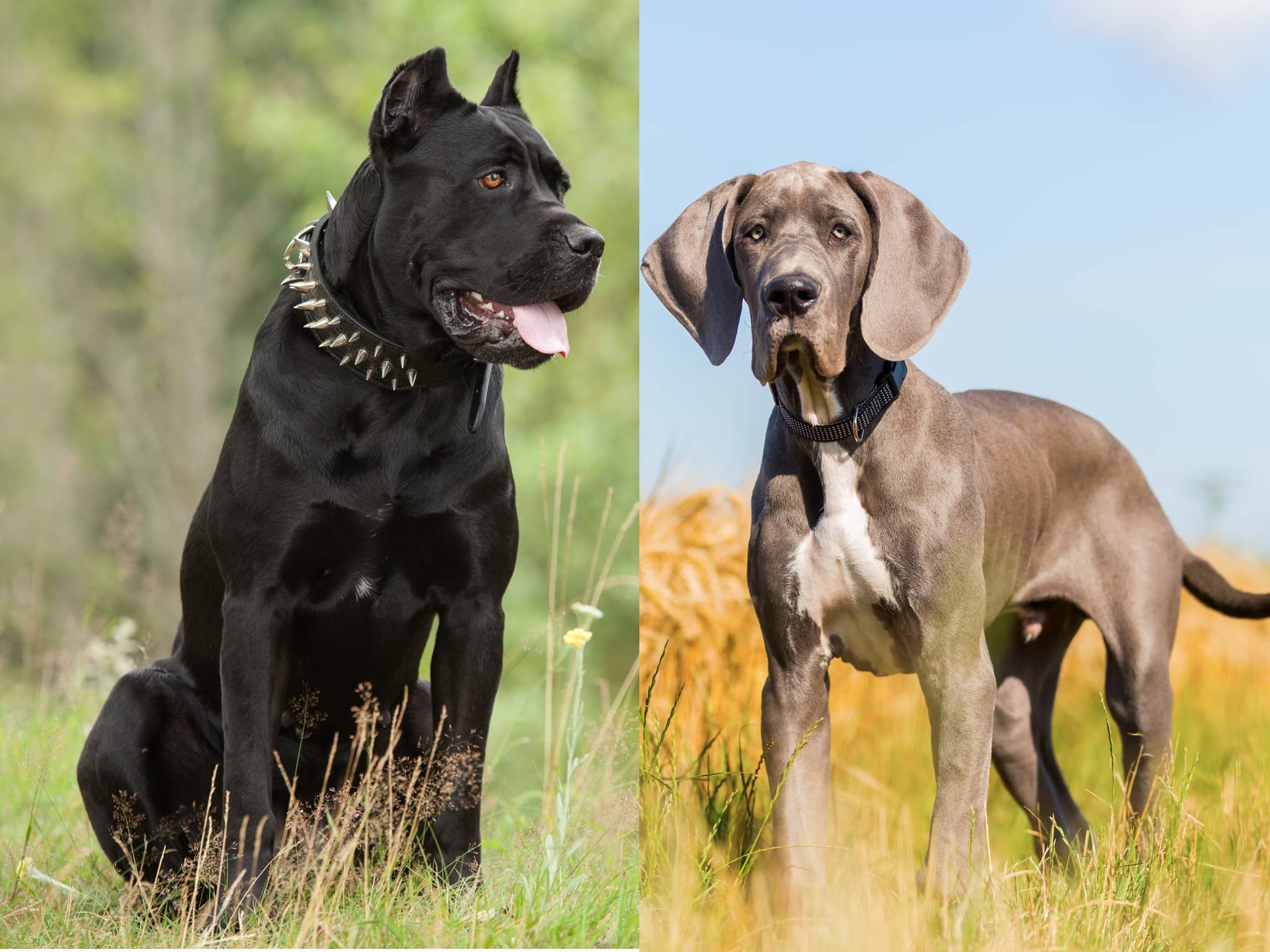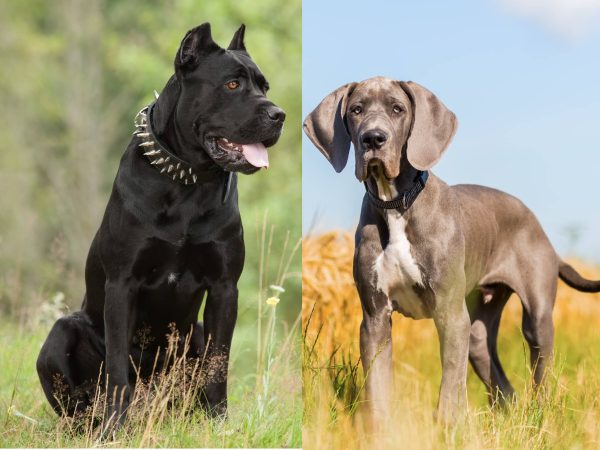Click Below to Skip Ahead
The term “Italian Daniff” doesn’t give much away about this breed. It may not be hard to deduce that a Great Dane makes up half of this large and distinctive dog, but what about the other half? If you’re curious to know more about this unique and special mix, this guide shares all you need to know.
Breed Overview
Height:
23.5–32 inches approximately (based on Cane Corso and Great Dane average heights)
Weight:
100–175 pounds (based on Cane Corso and Great Dane average weights)
Lifespan:
8–12 years
Colors:
Black, blue, fawn, brindle, harlequin, merle, white, mantle, black and white, silver, red, gray
Suitable for:
Any loving and committed family, including families with children if the Italian Daniff is properly socialized
Temperament:
Gentle, intelligent, protective, loyal, dignified, may have a hint of stubbornness
The Italian Daniff is a cross between the Great Dane and the Cane Corso, both old breeds. The Cane Corso dates back to the Roman period, when these dogs were fighters, hunters, and farmhands. The Great Dane was developed in the Middle Ages from Mastiff-type dogs as a boar-hunting canine. Physically imposing and fiercely loyal yet by all accounts, sweet-natured, the Italian Daniff is a true medley of the best Great Dane and Cano Corso traits.
The Daniff’s height and weight may vary because a Cane Corso female can be relatively small at around 23.5 inches at the shoulder, whereas a male Great Dane can reach up to around 32 inches. Your Italian Daniff will likely fall somewhere between these two sizes.
Italian Daniff Breed Characteristics
Italian Daniff Puppies
Italian Daniff puppies aren’t very easy to find, and breeder prices for Cane Corso or Great Dane mix puppies tend to range from $600 to $1,500, but some breeders may charge more. There are Daniffs and other Great Dane/Cane Corso mixes in need of new homes on social media groups and rescue sites, however.
Based on this, you might want to check out rescue groups that rehome Great Dane or Cane Corso mixes. Even if you don’t find an Italian Daniff specifically, you’re sure to find an equally gorgeous mix that might be a great fit for you.

Temperament & Intelligence of the Italian Daniff
With any dog, you can’t really predict what their personality will be like until you meet them and get to know them, but the Italian Daniff descends from two highly intelligent breeds with a strong work ethic. This means the Daniff is likely to be similar in terms of intelligence and trainability.
Both the Cane Corso and the Great Dane are known for being alert, dignified, and confident. The Great Dane, in particular, is famously a gentle giant and loyal protector, and the Cane Corso is typically a lovable dog and totally devoted to their human family, but they may also possess a stubborn streak. The Italian Daniff will most likely have a mix of these traits.
Are These Dogs Good for Families? 👪
If the Italian Daniff’s family takes the time to properly socialize them with children, this dog is sure to make a gentle and patient companion. Children will need to learn how to interact with them respectfully and sensibly, so if you have very young kids, they’ll need to be closely supervised around the Daniff to make sure no grabbing or tail-pulling, for example, is going on.
If you’re planning on adopting an adult Italian Daniff, you can find out more about how well they get along with children from the rescue organization.
Does This Breed Get Along With Other Pets? 🐶 😽
The Italian Daniff can certainly get along with other dogs and cats in the household, but this depends on whether you socialize your Italian Daniff with your other pets. When you bring your puppy home, you’ll want to gradually introduce them over several days and weeks in a safe environment and under supervision.
If your Daniff is an adopted adult, find out as much as you can about their history and relationship with other pets. For example, if the dog has never been exposed to cats and you have kitties at home, they may not be the best fit for your household. However, if they have formed positive relationships with cats in the past, it could work.
Things to Know When Owning an Italian Daniff
Food & Diet Requirements 🦴
A high-quality commercial formula is the best kind of food for an Italian Daniff. You might want to consider a formula made specifically for large dogs, but any formula that meets their dietary requirements and is suitable for their age range is fine. For example, if your Daniff is a puppy, they’ll need a recipe tailored to puppies, not adult dogs.
The Great Dane is known to be prone to a dangerous health condition called bloat, which may be caused by eating too quickly. For this reason, your Daniff may do best with several small meals over the course of the day instead of one big meal. If they have a tendency to devour up their food in a flash, a slow feeder could help.
Exercise 🐕
Each individual dog has different needs when it comes to exercise, so pay attention to your Italian Daniff’s health and how quickly they tire to get the best measure of how much daily exercise is appropriate for them. Your vet is the best person to advise an approximate length of time for daily exercise.
To give you an idea of how much an adult Italian Daniff may need, the PDSA recommends around 2 hours per day for both Cane Corsi and Great Danes. This time includes two or three walks per day, play sessions at home (both with you and with toys), and general training exercises.
Be careful with how much you exercise your Italian Daniff puppy. Great Dane puppies are at risk of joint damage if they overexert themselves too much at a young age (such as going jogging or on long hikes) because they grow at such a rapid rate.
You might need to wait until your Italian Daniff puppy is fully matured (which could take up to 2 years) before letting them do certain activities. Speak to your vet about how much exercise would be appropriate and the kinds of activities your large-breed puppy can safely engage in.
Training 🎾
Training any breed is of paramount importance, but for large breeds, it’s especially important—no matter how sweet-natured the dog is. A huge, powerful, and untrained dog is a recipe for disaster. For example, if a dog the size of a Cane Corso or Great Dane were to jump up on a passerby who wasn’t very sturdy, this could result in serious injury for them and possibly legal trouble for you.
Luckily, Italian Daniffs are smart, responsive dogs, so they should be able to quickly pick up basic but crucial commands like “sit,” “stay,” “come,” and “down” as long as you use positive reinforcement methods.
Find out what motivates your Daniff (treats, toys, or praise) and use this to mark their successes, reward them, and ultimately, encourage more of the same good behavior. If the Italian Daniff inherits the Cane Corso’s stubborn streak, it may make training a bit more of a challenge, but there’s nothing that consistency and patience can’t sort out!
One of the best ways to supplement the training you’ll do at home is to get your Daniff signed up for obedience classes as early as possible. Work with a professional trainer if you’re having a hard time—it’ll be worth it!
Grooming ✂️
Great Danes don’t shed much, and Cane Corsos shed moderately throughout the year. On this basis, you can expect to brush your Italian Daniff about once per week with a bristle brush to remove dead hairs, but during spring and fall, you might need to brush them every day, as they lose more hair in shedding seasons.
It’s also crucial to keep your Italian Daniff’s nails trimmed. When a dog’s nails get too long, normal activities like taking a walk can become painful for them. Check the ears regularly too, as dirt and debris can build up and cause an infection. If they need to be cleaned, you can do this with a dog-safe ear-cleaning solution.
Health and Conditions 🏥
Deep-chested large dogs are especially susceptible to bloat (gastric dilatation-volvulus). This condition affects Great Danes in particular and is, according to the AKC, “the number-one killer” of this breed. Not much is known about what causes bloat, but possible risk factors include eating or drinking too much too quickly and exercising just after eating.
Hip dysplasia and elbow dysplasia are two other conditions that may affect Italian Daniffs. These occur when the joint loosens in the socket, causing pain and discomfort. Great Danes might also be prone to heart disease, but it can affect any breed.
- Minor stomach upset
- Mild allergies
- Bloat
- Hip dysplasia
- Elbow dysplasia
- Heart disease
Male vs. Female
The differences between male and female dogs are largely biological. Sex doesn’t really affect a dog’s character; it comes down to the individual dog, genetics, and how well they’ve been socialized.
Males are often larger than females, and females experience bleeding during the proestrus stage (the first stage) of the heat cycle. Unspayed females in heat may also be more anxious, irritable, fidgety, or likely to roam in an attempt to find a mate. Having your female dog spayed will prevent her from going into heat.
If an unneutered male dog smells a female in heat nearby, he may be more likely to become territorial, aggressive toward other dogs, display roaming behaviors, and mark territory by spraying urine, and he may become more difficult to manage in general.
Neutering may help to stop or reduce some of the behaviors exacerbated by high testosterone levels, but it’s important to remember that neutering and spaying can’t change ingrained and habitual behavioral patterns. Only proper socialization and training can do this.
4 Little-Known Facts About the Italian Daniff
1. Cane Corsos Were Once Battle Dogs
One of the Italian Daniff’s parent breeds, the Cane Corso, dates back to ancient Rome. The Roman army used these dogs in battle, sending them to charge at the enemy with fire. They were referred to as “pireferi.” When they were no longer needed in battle, they adapted to life as farm dogs and hunters.
2. A Great Dane Is the World’s Tallest Dog
Great Danes are enormous dogs, so it’s no wonder that Italian Daniffs can grow to be pretty large. A Great Dane from Texas called Zeus was confirmed to be the world’s tallest dog. Zeus stood at 1.046 meters (3 ft 5.18 inches) tall, had a fear of rain, loved making new friends, and enjoyed life in the slow line.
3. “Cane Corso” Has a Special Meaning
In Latin, “Cane Corso” translates to “bodyguard dog.” This truly does the breed’s reputation for fierce loyalty justice.
4. Great Danes Aren’t Actually Danish
The breed as we know them today originated in Germany, and it is not known how they ended up being associated with Denmark. The French coined the term, “Grand Danois,” which translates to “Great Dane.”
Conclusion
The enormous but sweet-as-pie Italian Daniff would fit perfectly into any family who will give them affection and a safe and warm home and dedicate time to exercising, training, and socializing them every day.
It’s important to remember that an Italian Daniff is—quite literally—a huge commitment in terms of their care requirements, socialization and training needs, and the financing of their care (food, veterinary checkups, initial supplies, etc.), so getting one is not a decision to be taken lightly.
Related Read:
Featured Image Credit: Left (Cane Corso) Hoika Mikhail, Shutterstock, Right (Great Dane) Christian Mueller, Shutterstock














